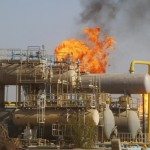Oil Production 2014

The world’s oil supply has shrunk considerably over the last few decades. Countries, mostly in the Middle East, with what seemed like a never-ending amount of oil, have begun limiting their exports. Some oil fields, such as the ones in Texas that supplied American citizens for hundreds of years have closed down all together. And with new sources of energy reducing the world’s dependency on oil as the main energy resource, U.S. dependency on foreign oil has dropped significantly.
Still, crude oil continues to hold an important position internationally in both the economic and political arenas. In light of this, it seems strange that stock traders and oil investors had largely ignored the Syrian conflict and the so called Arab Spring that has erupted in many countries in the Middle East. Investors are also ignoring the conflicts in Russia, the Ukraine and Crimea and will probably continue this trend when it comes to Iraq as the fighting there escalates further. Crude oil prices continue to rise and is hovering around $105 a barrel.
Despite the pull-back in oil imports, however, there is no way of getting around the fact that what happens in the Middle East will surely affect oil prices worldwide.
Lack of Data
Amazingly, there is very little data available about the countries that currently supply the U.S. with its oil needs or even a listing of how much oil is produced locally, in Alaska for example. The last figures posted on the official State of Alaska website indicated that there production stood at 18.023 million barrels in March 2014. But that was the last report I was able to find.
In February of this year, the U.S. Energy Information Administration reported that the state of North Dakota, which is the No.2 oil producer in Energy information Administration(eia) the United States, produced 29.1 million barrels November, 2013, an all-time high for the state but roughly half of what Texas produced the same month. The North Dakota Industrial Commission said the state’s rig count was down 12 percent from its record set in mid-2012.
Europe
Europe maintains a small role in the oil markets but in an effort to lessen dependency on the oil-rich Arab countries, many EU countries are trying other means in order to meet their own energy needs and more drilling is taking place along the sea coasts in an effort of finding additional oil reservoirs. Another way to increase its local oil supplies is to partner with North American oil companies. In June of this year, ExxonMobil announced that it was investing over $1 billion at its Antwerp refinery.
Investors are looking to Canada for additional oil supplies and anticipate the country moving up from its current 4th place in oil production. But progress is slow and it cannot be depended upon.
It will probably be quite a while before Europe and America are able to stand on their own when it comes to supplying the needs of its citizens. For the moment, U.S. energy needs will continue to depend on the import of oil from foreign countries with the Middle East remaining as the main supplier.
Author: OneStopBrokers





























